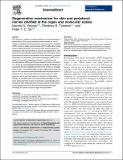Regeneration mechanism for skin and peripheral nerves clarified at the organ and molecular scales
Author(s)
Yannas, Ioannis V; Tzeranis, Dimitrios; So, Peter T. C.
Download1-s2.0-S2468451117300843-main.pdf (1.393Mb)
PUBLISHER_CC
Publisher with Creative Commons License
Creative Commons Attribution
Terms of use
Metadata
Show full item recordAbstract
This article is a review of current research on the mechanism of regeneration of skin and peripheral nerves based on use of collagen scaffolds, particularly the dermis regeneration template (DRT), which is widely used clinically. DRT modifies the normal wound healing process, converting it from wound closure by contraction and scar formation to closure by regeneration. DRT achieves this modification by blocking wound contraction, which spontaneously leads to cancellation of scar formation, a process secondary to contraction. Contraction blocking by DRT is the result of a dramatic phenotype change in contractile cells (myofibroblasts, MFB) which follows specific binding of integrins α1β1 and α2β1 onto hexapeptide ligands, probably GFOGER and GLOGER, that are naturally present on the surface of collagen fibers in DRT. The methodology of organ regeneration based on use of DRT has been recently extended from traumatized skin to diseased skin. Successful extension of the method to other organs in which wounds heal by contraction is highly likely though not yet attempted. This regenerative paradigm is much more advanced both in basic mechanistic understanding and clinical use than methods based on tissue culture or stem cells. It is also largely free of risk and has shown decisively lower morbidity and lower cost than organ transplantation. Keywords: Regeneration, Skin, Peripheral nerves, Phenotype change, Contraction blocking, Integrin-ligand interaction
Date issued
2017-12Department
Massachusetts Institute of Technology. Department of Biological Engineering; Massachusetts Institute of Technology. Department of Mechanical EngineeringJournal
Current Opinion in Biomedical Engineering
Publisher
Elsevier BV
Citation
Yannas, Ioannis V., Dimitrios S. Tzeranis, and Peter T.C. So. “Regeneration Mechanism for Skin and Peripheral Nerves Clarified at the Organ and Molecular Scales.” Current Opinion in Biomedical Engineering 6 (June 2018): 1–7.
Version: Final published version
ISSN
2468-4511